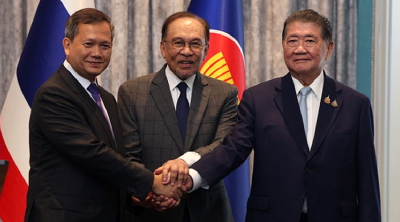It is great that the country aspires to transform its economic structure from over-reliance on the “double oils” to AI-driven innovative new industries. But, we need to have a whole set of plans to see to their materialization.
Malaysia’s GDP stood at US$407.9 billion in 2022, trailing behind Indonesia, Thailand and Singapore in the region, ranking 35th globally.
Sectorally, services industry took up 50.9%, followed by manufacturing at 39.2%, and agriculture 8.9%.
Going further, Petronas’ revenue chalked up US$85.4 billion (ranking 139th globally), while exports of palm oil products stood at $31.2 billion. Collectively, these two sectors made up 28.6% of the country’s GDP last year, hinting an precariously high dependence on petroleum and palm oil.
Meanwhile, the EV industry is developing at breakneck paces worldwide, and it is estimated that by 2030, the global sale of EVs will overtake that of conventional fuel-powered vehicles for the first time ever, spelling an end to Petronas’ glorious days.
Additionally, the annual production of vegetable oils globally is estimated at around 200 million tons, of which soy (27%) and palm oil (36%) constitute about 63% of the total.
However, due to the far lower production cost of palm oil, the commodity has found itself under various forms of restrictions in the US and EU markets.
Besides, Indonesia’s production is picking up fast, casting a gloom over the industry’s future outlook.
Over the next ten years, the Malaysian economy may lose the strong bolster from these two oils, and it is now time for us to explore how to transform the country’s economic structure in order to wean ourselves from excessive dependence on these commodities in transition to other more sustainable emerging sectors for the country’s future development.
Highly polluting, energy-intensive, labor-intensive, and low-value conventional industries will have to give way. So, which way should we be headed to?
During the recent unveiling of the New Industrial Master Plan (NIMP) 2030 and the mid-term review of the 12th Malaysia Plan, PM Anwar Ibrahim proclaimed in black and white the four major missions of the NIMP.
First, to advance economic complexity, where industries will be encouraged to innovate and produce more sophisticated products.
Second, to embrace technology and digital transformation to drive innovation and enhance productivity.
Third, to push for net zero emission through sustainable practices and green initiatives.
Fourth, to safeguard economic security and inclusivity by ensuring supply chain security.
The prime minister said the NIMP will deliver great significance to the country’s industrial development and transformation, at the same time wielding a tremendous impact on the national economy.
Under the aforementioned key missions, E&E, chemical, EV, aerospace, pharmaceutical, and sophisticated materials (such as minerals and metals) industries are poised to be prioritized sectors for future development.

Science, technology and innovation minister Chang Lih Kang has been quick in responding positively to the prime minister’s NIMP initiative by proposing to set up a space launch program.
Given the perception that minister Chang’s notion appears to be “impractical,” it has since invited criticisms from all quarters.
The minister says the construction of the space launch site will boost the aerospace production chain, and the technologically highly demanding industry is set to create thousands of high-paying and tech-heavy job opportunities for Malaysians.
This will help keep the relevant talents within our shores.
He says the implementation of the space launch project will boost the tens of billions ringgit worth of aerospace production chain, such as supply, manufacture, assembly and testing of rocket and satellite parts and components, launching and tracking systems, insurance and space research. All these will eventually be hosted here in Malaysia.
Time will tell whether the minister’s conception is workable.
While we support high-tech industry and the development of peripheral products and services, we nevertheless do have a couple of questions for the decision-makers:
First, how will these projects be funded? According to the minister, they will be funded privately, but have we managed to get local entrepreneurs keen to invest in these sectors?
Second, where to source the talents required? Are any of our existing universities offering aerospace-related courses to produce “thousands” of skilled workforce required annually?
Third, have we conducted any study on the viability of fringe services of the space launch program?
Fourth, have we already identified the location of the space launch site?
Aerospace industry is not just about launching a rocket, but will also encompass the R&D, manufacture and logistics maintenance of aircraft (or flying cars) and their parts and components.
As aerospace industry is a yardstick of a country’s industrial sophistication and intrinsically entails the dual missions of national defense and economic development, no country will unreservedly transfer its technologies to us, on security grounds.
Well, it is great that the country aspires to transform its economic structure from over-reliance on the “double oils” to AI-driven innovative new industries, but we need to have a whole set of plans to see to their materialization.
ADVERTISEMENT
ADVERTISEMENT








































